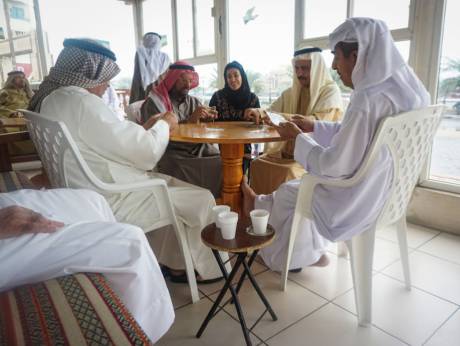A taste of history in the Heart of Sharjah
12:21PM Wed 13 Jul, 2016

The tour of the heritage precinct takes visitors back in time, offering glimpses of what life was like in the days of yore
People. Places. Stories. Meld these with some riveting facts of history, layer it with bits of trivia and dollops of nostalgia, throw in some flavourful food that embodies the essence of timeless simplicity and what you get is a heavenly concoction that is both gratifying and soul-stirring.
Standing on the foundations of an old town in Sharjah that was well established by the 19th century, we listen in rapt attention as Arva Ahmed, food blogger and Chief Executive Muncher of Frying Pan Tourism LLC, explains how the traditional cooling wind towers and open courtyard homes of what was once a lively fishing and trading hub were demolished in the 1970s to make way for an urban development plan comprising modern commercial and residential blocks.
We are here as part of the newly launched Savour the Heart of Sharjah trail that takes one through the heart of the city, the very birthplace of the emirate and a vibrant area of historical importance that is now being restored based on the original 1950s blueprint of the region to give us an inkling of what Sharjah was like more than half a century ago.
Savour the Heart of Sharjah trail is an amalgamation of food, history and culture, and is organised in association with the Heart of Sharjah project. Ahmed, who initiated the UAE’s first food-based tour in Dubai in 2013, is accompanied by Fatima Salim Al Shuweihi, an Emirati who is also the head of events for Heart of Sharjah.
The rhythmic lapping of the waters of the Creek and the tranquil setting of the traditionally styled low-rise buildings provide a perfect backdrop to the #savourSHJ trail. Soothed by a caressing breeze, we meander through alleyways, majlises and masterfully restored traditional homes as we set out to discover the stories and flavours tucked away in this historic district.
It is precisely these stories and the people we meet that form the crux of the #savourSHJ trail. At the Majlis Al Shaabi, a recreation centre for the elderly gentlemen of the area, senior members regale us with tales of the early days of fishing and trading. “It was a simple life we led then,” says an octogenarian engaged in a game of cards with his friends. “Our needs were basic, our food was rustic, and our wants were few.”
Dr Hussain Al Muttawa, a retired professor, says, “This majlis is a vital part of our heritage. It is here, by listening to the older generation that we learn more about our history and gain a deeper insight into life itself.”
Over a refreshing cup of piping hot, sweet karak chai, we flip through an album and observe how much has changed around us. “Change is inevitable in every society; the old has to give way to the new,” he says.
Our olfactory nerves pick up the sweet aroma of halwa cooking as we make our way through the 200-year-old Souq Al Arsa, one of the oldest market places in the UAE. The tantalising whiff leads us to an Omani sweet factory where four skilled halwa makers are stirring the bubbling caramelised sugar syrup in wide copper pots with large paddle-like spoons.
“Constant stirring is required to ensure that no lumps are formed,” says Asghar, as he throws spoonfuls of saffron infused rose water into the copper vessel, which holds about 50 kilograms of halwa. Biting into the warm and luscious gelatinous sweet, it is easy to understand why it graces the tables of every Omani home in times of both joy and sorrow.
With small shops straddling narrow alleys, designed with solid wooden doors, beautiful coral brick walls and hanging lanterns, Souq Al Arsa embodies the spirit and flavour of old Sharjah. A palpable sense of nostalgia is pervasive as you step into an antique store, every inch of space crammed with its owner’s rare collections — from clay pots and coffee makers to rifles, cameras, pocket watches and gramophones, some dating back more than hundreds of years.
If Souq Al Arsa took us on a journey back in time, it was the newly reconstructed Souq Al Shanasiyah that bridged the gap between the old and the new. Deriving its name from the merchants of the state of Shanas in Oman who used to populate the souq, this forms the connecting link between Souq Al Arsa and Souq Saqr and has been reconstructed on the original foundations of the old souq that were excavated few years ago.
Al Shuweihi leads us to the Archaeological Findings Room, which reveals details of the remains of the historic core of the city that lay underneath the tarmac of Bank Street, Sharjah’s first modern commercial street. Pottery, porcelain, coins and other artefacts unearthed in the excavation are on display here.
An eclectic mix of retail stores and restaurants make up the traditional market atmosphere of Souq Al Shanasiyah. Salted, preserved fish at Maleh Al Dar harks back to the Emirati tradition of preserving seafood at the end of the fishing season; tailored, bespoke Emirati menswear finds prominence at Bait Al Kandora while Al Saroud is the place to go for traditional Emirati cuisine.
However, it is Dukan Namlet that revives nostalgia with flavoured drinks in the Codd-neck bottle invented in Britain with the characteristic marble to protect the fizz. It brings out the child in each of us as we eagerly push down the marble to savour the soda. “Namlet” is a malapropism for “lemonade”, points out Al Shuweihi, and was a popular beverage in the UAE until the 1970s.
She also takes us to a new age café dedicated to speciality coffee whose wooden interiors have been fashioned out of the old dhow belonging to the owner’s father.
The sense of excitement and anticipation is noticeable as Al Shuweihi leads us through part of Souq Al Saqr towards Bait Al Serkal, the 150-year-old, three-storey structure converted into the Sarah Hosman Hospital in the 1960s, and the place where she was born.
We follow Ahmed on a leisurely stroll through shops featuring the latest designs in textiles and fabrics and come to a halt at a tiny, nondescript 30-year-old cafeteria where we taste sambusa in samoon — a deep-fried mixed vegetable samosa crushed in a hot dog bun, and drizzled with hot sauce (daqoos). Crunchy on the outside and oozing with tightly packed savoury goodness, we munch on the spicy filling when Ahmed throws in a shocker as she reveals that the samosa — India’s favourite snack — was never Indian but originated in the Middle East in the medieval times.
Wildly delicious and satisfying, all it cost was a princely sum of Dh2! Al Shuweihi recollects the time when its owner would go from home to home with a carton on his head, and roll out freshly fried sambusas, tightly stuffing them in the bread.
As we go past the 16th century Wall of Sharjah made of gypsum and dried coral, Ahmed points out the fully restored Al Hisn fort that stands majestically as a keeper of Sharjah’s history, having been the residence of the ruling Al Qasimi family. Past the Institute of Theatrical Arts lies the Goldsmith alley where Kolkata-based artisans are engaged in handcrafting silver and gold jewellery that will eventually make its way into jewellery stores across the nation.
Heading into Zam Zam Market, our first stop is at another long-running hole-in-the-wall establishment where for a mere Dh3, a fluffy stuffed Afghan flatbread liberally brushed with clarified butter was ours to devour. Crispy on the outside, soft and warm on the inside, the potato-chilli flavours hit all the right notes. To sweeten our palate we opt for a saffron peda at a nearby Indian sweet shop.
We then make our way to Al Salimiyah Nuts, a hallowed Sharjah institution that roasts assorted nuts with heated sand, toasting them to perfection. Anwar Sadat says his father started the business 40 years ago on a mobile food cart and garnered a cult following especially for his nakhey — baby chickpeas from Iran.
When the municipality confiscated the food cart several years ago, it was the Ruler of Sharjah who ordered a kiosk to be built for them to continue their business. “Our roasted nuts are still served in palaces and homes of dignitaries,” says a proud Sadat.
For our first sit-down meal of the day, Ahmed steers us to a popular 1970s restaurant, renowned for its simple but heartwarming fare. Famed for its bayd wa tamat (eggs and tomato), which artists at the nearby theatre reportedly consume before every show, we also relish with gusto the tender lamb chops and meat nashif (spiced meat and tomatoes in a reduced sauce).
Ahmed never takes no for an answer and she herds us into a 15-year-old Pakistani café that serves kulfi, the traditional ice cream of the Indian subcontinent. Dense and creamy, the cardamom-laced frozen dessert is licked clean in no time.
As the tour draws to a close, all I can think of is how inspiring it has been to witness and absorb the sights of the heritage area that has metamorphosed from the rubble of the 1800s to become one of the region’s largest historical preservation and restoration projects. What made it more intriguing was that with their impressive knowledge of the history of the area and the little-known nooks and crannies, Ahmed and Al Shuweihi have elevated the five-hour trail into a passionate, highly engaging and informative walking tour.
Sangeetha Swaroop is a writer based in Dubai. Follow her on Twitter @swarsang
Savour the Heart of Sharjah trails are conducted on January 16 and 28 from 10am to 2.45pm. The rate is Dh299 inclusive of the food and drinks ordered. For more details, go to www.fryingpanadventures.com/sharjah.
GulfNewsABU DHABI, 13th July, 2016 (WAM) -- Under the directives of H.H. Dr. Sheikh Sultan bin Mohammed Al Qasimi, Supreme Council Member and Ruler of Sharjah, the Sharjah Investment and Development Authority, Shurooq, has embarked on a major project to develop Heart of Sharjah as part of its efforts to protect the emirate’s valuable cultural heritage.
(Bhatkallys News Service)











